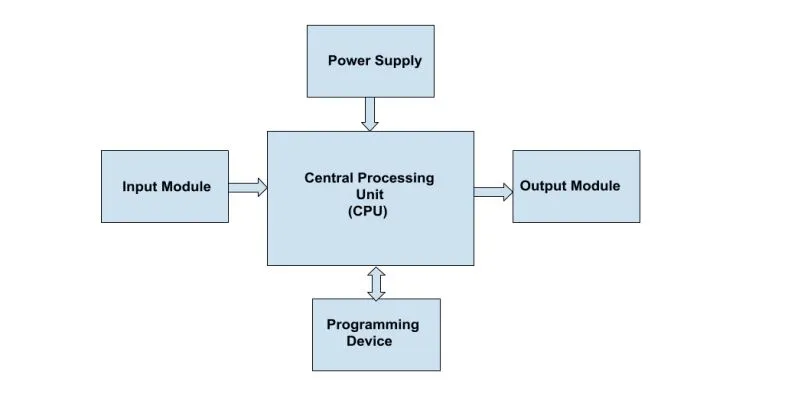What Is a Programmable Logic Controller (PLC)?
A Programmable Logic Controller (PLC) is a computer designed specifically to control
machines and processes in factories. PLCs are built to withstand harsh industrial
environments, featuring robust designs that are resistant to dust, moisture, and high
temperatures. By monitoring inputs and managing outputs, PLCs simplify complex
control tasks—from overseeing production lines to managing intricate operations in real
time.
Types of PLCs: Fixed and Modular
In general, there are two types of PLCs, each suitable for different applications:
- Fixed PLCs
These compact units have a predetermined number of inputs and outputs, making
them a budget-friendly option for smaller, standalone applications. However, expandability is
limited, which means they’re best suited for specific, unchanging control tasks. Fixed PLCs are
more complicated to change or fix, and if a defect occurs, it may be necessary to have a backup
unit in order to avoid excessive downtime.
- Modular PLCs
These offer more options as one can customize them by adding or removing
modules and thus they are suitable for large or changing industries. Though they tend to be
expensive and bulky, modular PLCs prevent prolonged system downtime since a given module
serves a specific function and so faults can be located without switching off the whole system.
What are the Key Components of a PLC System?
- Input Modules
Receive signals from sensors, devices such as switches and
buttons and change them into a format recognizable and manageable by the
PLC.
- Central Processing Unit (CPU)
Also referred to as the “brain” of the PLC, the
CPU interprets input signals and executes programmed instructions to control
outputs.
- Output Modules
These modules manage output devices like motors, lights, and
actuators.
- Power Supply
Provides the required operating power for the PLC and its
components.
- Programming Device
A device, usually a computer, used to program the PLC.
How PLCs Work?
The operation of a Programmable Logic Controller comprises three steps that run recurrently for
the purpose of providing control in real time.
- Input Scanning
The PLC scans and reads signals from any input device
connected such as sensors, momentary switches and other switches.
- Program Execution
The program downloaded into the PLC evaluates the input
data and determines the corresponding output actions.
- Output Activation
The PLC sends signals to the output devices, such as
motors, lights, and actuators, to perform the tasks it has been programmed to do.
This sequence occurs repeatedly at a higher rate so as to ensure that the PLC is able to
react quickly to varying input conditions. Inputs and outputs (I/O) can be either Digital
(on/off) or Analog (range of values, like a dimmer switch), which increases the scope of
operations that a PLC can perform.
What are the Common PLC Programming Languages?
PLCs are programmed using languages designed for efficiency and ease of use in industrial
applications. Commonly used PLC languages are:
- Ladder Logic
Resembles relay logic diagrams and is user-friendly for
technicians.
- Function Block Diagrams (FBD)
Uses blocks to represent functions and their
inputs/outputs.
- Structured Text (ST)
High-level, text-based language suitable for complex
processes.
What are the Advantages of PLCs?
PLCs have become essential in industrial automation due to several significant advantages:
- Reliability
The solid-state design makes them less prone to failures, making
them more durable than mechanical relay systems.
- Scalability and Flexibility
Modular PLCs can be expanded or modified to
accommodate changing requirements and demands.
- Speed
PLCs process inputs and outputs quickly, providing real-time control of
processes.
- Cost-Effectiveness
While initial investment can be high, PLCs reduce
long-term maintenance costs and increase productivity.
- Minimal Wiring Requirement
PLCs consolidate control systems, minimizing
the need for extensive wiring, which makes installation easier and keeps work
areas less cluttered.
PLC Applications
- 1. Industrial Process Control
Used in chemical, petrochemical,
and pharmaceutical industries to monitor and control complex
operations.
- 2. Factory Automation
PLCs help in running assembly lines,
packaging machines, and material handling in manufacturing
plants.
- 3.Food Processing
Helps with mixing, packaging, and
maintaining quality standards in food and beverage industries.
- 4. Water Treatment Management
PLCs regulate purification
process, check water quality, and handle distribution in treatment
plants.
- 5. HVAC Control
Manages heating, ventilation, and air
conditioning systems by regulating temperature, humidity, and air
quality.
The Future of PLCs
Understanding the basics of Programmable Logic Controllers (PLCs) is crucial for
mastering modern machine control, as they form the backbone of industrial automation.
A Programmable Logic Controller, or PLC, is an industrial computer that can be
programmed to control machinery and processes in various industries. With
components such as a CPU, input/output modules, and a programming device, PLCs
are versatile tools, integral to applications ranging from simple control tasks to complex
automation systems. For anyone new to industrial automation, understanding PLCs is
an essential first step.
PLCs remain evolving with technology. There are newer products in the form of
Programmable Automation Controllers (PACs), which combine the functionality of PLCs
with higher-level PC functionality. Even with these innovations, PLCs remain widely
popular for their affordability, simplicity, and effectiveness.
Cognidel is a leading industrial automation training institute renowned for its hands-on, industry-oriented programs, particularly in the field of Programmable Logic Controllers (PLCs), SCADA systems, and related automation technologies. With a strong focus on practical learning, Cognidel equips students and professionals with real-world skills through hands-on labs and industry-based projects. Recognized for its quality and commitment, it stands out as a top destination for PLC training in Bangalore, helping learners build a solid foundation and advance their careers in the automation sector.
